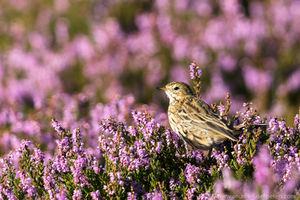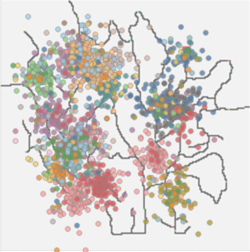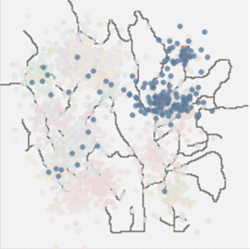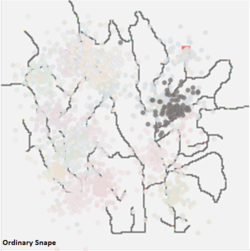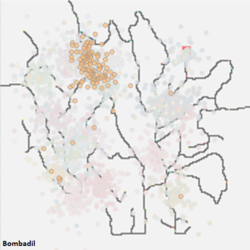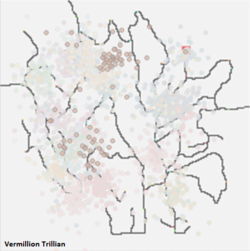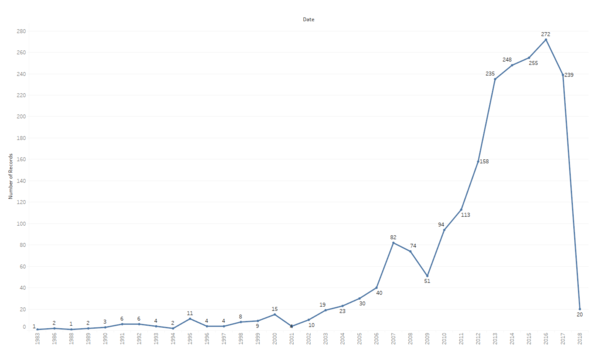ISSS608 2017-18 T3 Assign Anthony Theodore Findings
|
|
|
|
|
Initial Exploration
Below is the distribution of all bird inside Lekagul Preserve that are detected by sensors. While there are many different species inside Lekagul Preserve, only Rose-crested Blue Pipit is seen grouping in the alleged dumping site area. Note that there are 2 cluster visible in the map, which are directly above the alleged dumping site, and to the south of said dumping site.
Thus looking at this behavior, it made sense that the Kasios was blamed with the disappearance of Rose-crested Blue Pipit. Of all species that live inside Lekagul Preserve, Rose-crested Blue Pipit is the species that will greatly be affected by the dumping situation.
However, not only Rose-crested Blue Pipit, but other species, such as Ordinary Snape is also seen grouping near the dumping site.
Bombadill and Vermillion Trillian is also spotted grouping near the dumping site, albeit further than Ordinary Snape and Rose-crested Blue Pipit.
We will use all this species as our control group because if indeed the dumping site was the cause of Rose-crested Blue Pipit disappearance, then these species should also be affected. As mention in the description, the extent of the area affected by the dumping site is unknown. In our approach, we mention that we only use the data from 2006 - 2017. The reason for this decision was, even though the assignment description stated that the patterns are reasonably representative of the bird locations across the area, all birds did not have significant record until 2006, as seen from the graph. We excluded 2018 because the data recorded for 2018 are until Q1, and has insufficient data for the rest of 2018.
Situation inside Lekagul Preserve
1. Disappearance of many birds
Initially, the population of Rose-crested Blue Pipit were increasing. They peaked at 2015, but then gradually decreased until 2017. This may indicate that there is indeed something happened with the Rose-crested Blue Pipit, and by visualizing year by year cluster of the bird, we can see that the bird actually moved away in 2015, as seen below:
Image of rose crested by year
The cause of this migration is unknown, but we could assume that it has something to do with the alleged waste dumping taking place, since Rose-crested Blue Pipit is the only bird that cluster in the alleged dumping area, and no other bird display such drastic migration.
For comparison, we will show our control group situation. Ordinary Snape is a species nearest to the dumping site. If we see at the year by year position, it is very clear that they never migrate outside their cluster, unlike Rose-crested Blue Pipit. However, their population is also decreasing, albeit not as much as Rose-crested Blue Pipit variant.
IMAGE ordinary snape
The same case also happening with Bombadil and Vermillion Trillian species. However, Vermillion Trillian species only decreased a little bit, and start to stabilized at 2015.
bombadil image verillion trillian image.
Below is the gallery image of all other birds (other than control group) position year by year.
- Galerella sanguinea Zoo Praha 2011-2.jpg
Galerella sanguinea (Slender Mongoose)
- Felis silvestris silvestris.jpg
- Six weeks old cat (aka).jpg
Felis silvestris catus (A Young Cat)
- Felis catus-cat on snow.jpg
Felis catus (cat on snow)
- Tired 20-year-old cat.jpg
Felis silvestris catus (Tired 20-year-old cat)
- Cat November 2010-1a.jpg
Felis silvestris catus (Cat)
- Felis silvestris silvestris Luc Viatour.jpg
Felis silvestris silvestris (European wildcat)
- June odd-eyed-cat cropped.jpg
Felis catus (Domestic cat)
- Lynx kitten.jpg
Lynx lynx (A Young Lynx)
Link for the dashboard:
As we look through the plot of each bird species, we notice some anomaly detected. Not only Rose-crested Blue Pipit and our control group suffer from the same disappearance, many of other birds away from the dumping site also suffer the same fate. If indeed it was caused by the dumping took place, then birds far away from the dumping site should not be affected by it. This call for concern as there are probably other dire situation that affected the bird population inside Lekagul Preserve. The following is the list of bird species that have decrease throughout the year.
Bird 1 Image 1
Bird 2 Image 2
Bird 3 Image 3
Bird 4 Image 4
Bird 5 Image 5
Bird 6 Image 6
Bird 7 Image 7
2. Change of birds behaviour
IMAGE of sound and call
By plotting sound and call in one chart, we can see that in 2015, as the population of Rose-crested Blue Pipit started to decrease, the number of call also increased to almost double than the number of song detected. This finding match the earlier finding we acquired, that in 2015 Rose-crested Blue Pipit migrate away from their initial cluster (the dumping site).
The reason why we want to closely look for the vocalization type, referencing on http://www.avianwelfare.org/shelters/pdf/NBD_shelters_minimize_stress.pdf, is that call can seldom be interpreted as sign of distress from birds, and one of the sign that should be look for. Since it is match with our finding earlier, this can indicate that the Rose-crested Blue Pipit population may indeed in stressed condition.
As for our control group, Ordinary Snape species has the same anomaly in behavior as Rose-crested Blue Pipit.
image for OS sound call
Bombadil and Vermillion Trillian both are not greatly affected by the dumping site, and retain their chirpy behavior throughout the year, although some call still detected.
image for BM and VT sound call
Interesting finding for Vermillion Trillian, even though there are spike on the amount of call detected in 2013-2014, they eventually decrease. This match the finding earlier that the population of Vermillion Trillian species stabilize in 2015 after decreasing.
3. Key Observation
Some key observation in our finding:
Vocal Characteristic
Test Kasios refute on Rose-crested Blue Pipit
